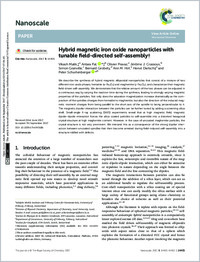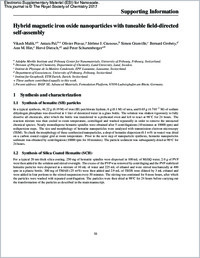Hybrid magnetic iron oxide nanoparticles with tunable field-directed self-assembly
- Malik, Vikash Adolphe Merkle Institute and Fribourg Center for Nanomaterials, University of Fribourg, Fribourg, Switzerland
- Pal, Antara Division of Physical Chemistry, Department of Chemistry, Lund University, Lund, Sweden
- Pravaz, Olivier Adolphe Merkle Institute and Fribourg Center for Nanomaterials, University of Fribourg, Fribourg, Switzerland
- Crassous, Jérôme J. Division of Physical Chemistry, Department of Chemistry, Lund University, Lund, Sweden
- Granville, Simon Institut de Physique de la Matière Condensée, EPF Lausanne, Lausanne, Switzerland
- Grobéty, Bernard Department of Geosciences, University of Fribourg, Fribourg, Switzerland
- Hirt, Ann M. Institut fur Geophysik, ETH Zurich, Zurich, Switzerland
- Dietsch, Hervé Adolphe Merkle Institute and Fribourg Center for Nanomaterials, University of Fribourg, Fribourg, Switzerland
- Schurtenberger, Peter Division of Physical Chemistry, Department of Chemistry, Lund University, Lund, Sweden
-
2017
Published in:
- Nanoscale. - 2017, vol. 9, no. 38, p. 14405-14413
English
We describe the synthesis of hybrid magnetic ellipsoidal nanoparticles that consist of a mixture of two different iron oxide phases, hematite (α-Fe2O3) and maghemite (γ- Fe2O3), and characterize their magnetic field-driven self-assembly. We demonstrate that the relative amount of the two phases can be adjusted in a continuous way by varying the reaction time during the synthesis, leading to strongly varying magnetic properties of the particles. Not only does the saturation magnetization increase dramatically as the composition of the spindles changes from hematite to maghemite, but also the direction of the induced magnetic moment changes from being parallel to the short axis of the spindle to being perpendicular to it. The magnetic dipolar interaction between the particles can be further tuned by adding a screening silica shell. Small-angle X-ray scattering (SAXS) experiments reveal that at high magnetic field, magnetic dipole–dipole interaction forces the silica coated particles to self- assemble into a distorted hexagonal crystal structure at high maghemite content. However, in the case of uncoated maghemite particles, the crystal structure is not very prominent. We interpret this as a consequence of the strong dipolar interaction between uncoated spindles that then become arrested during field-induced self- assembly into a structure riddled with defects.
- Faculty
- Faculté des sciences et de médecine
- Department
- Département de Géosciences, AMI - Soft Nanoscience
- Language
-
- English
- Classification
- Engineering materials
- License
-
License undefined
- Identifiers
-
- RERO DOC 305693
- DOI 10.1039/C7NR04518B
- Persistent URL
- https://folia.unifr.ch/unifr/documents/306133
Other files
Statistics
Document views: 184
File downloads:
- Texte intégral: 139
- Texte intégral: 147

